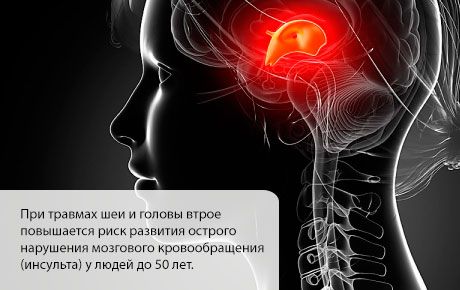Medical expert of the article
New publications
The likelihood of stroke increases in the first few months after a head or neck injury
Last reviewed: 01.07.2025

All iLive content is medically reviewed or fact checked to ensure as much factual accuracy as possible.
We have strict sourcing guidelines and only link to reputable media sites, academic research institutions and, whenever possible, medically peer reviewed studies. Note that the numbers in parentheses ([1], [2], etc.) are clickable links to these studies.
If you feel that any of our content is inaccurate, out-of-date, or otherwise questionable, please select it and press Ctrl + Enter.
In the course of new research, scientists from the United States have established that neck and head injuries increase the risk of developing acute cerebrovascular accident (stroke) threefold in people under 50. Scientific papers devoted to this problem were reviewed at an international conference devoted to the problem of strokes.

In their new research project, scientists analyzed the health of more than a million patients under 50 years of age who had suffered head or neck injuries in the past. It turned out that out of 100 people, 11 had a stroke in the first month after the injury. In the United States alone, about two million people visit emergency rooms every month with various injuries, and according to experts, more than two hundred people are hospitalized with ischemic stroke after suffering an injury. On average, the age of patients who developed a stroke after receiving any injuries was around 37 years.
As the scientists themselves note, their discovery is quite important for science and medicine, since knowing that injuries increase the likelihood of a stroke, an additional examination should be carried out when a person is admitted to the hospital. According to experts, the cause of strokes is the rupture of blood vessels in the head and neck, through which important nutrients enter the brain. When an injury occurs, these vessels become blocked, which leads to the development of such a life-threatening condition in the near future.
Doctors believe that if a ruptured vessel is detected immediately after a person is admitted to hospital with an injury, then a stroke can be prevented with the help of special antithrombotic therapy. Research has shown that a tenth of patients who have had a stroke have such damaged vessels, but very few have been examined for this pathology before the stroke.
The research team noted that their analysis looked at more cases of patients admitted to emergency departments with various head or neck injuries. In their future studies, the researchers plan to narrow the scope of their studies and look at individual cases and specific types of injuries, such as spinal fractures, following severe road accidents.
Read also: Head injuries increase the risk of hemorrhagic stroke tenfold
Recent studies have also shown that significant fluctuations in daytime temperature with medium and high humidity increase the risk of cerebrovascular accidents. At the same time, scientists have found that a decrease in average annual temperature also increases the risk of stroke and death as a result of this serious condition. According to researchers, weather conditions can become the main stress factors for people who are at risk and therefore they need to be able to act wisely in the event of the first signs of this condition. According to the experts themselves, several more studies need to be conducted to more accurately understand the mechanism of action of climate change on the health of blood vessels in the brain.

